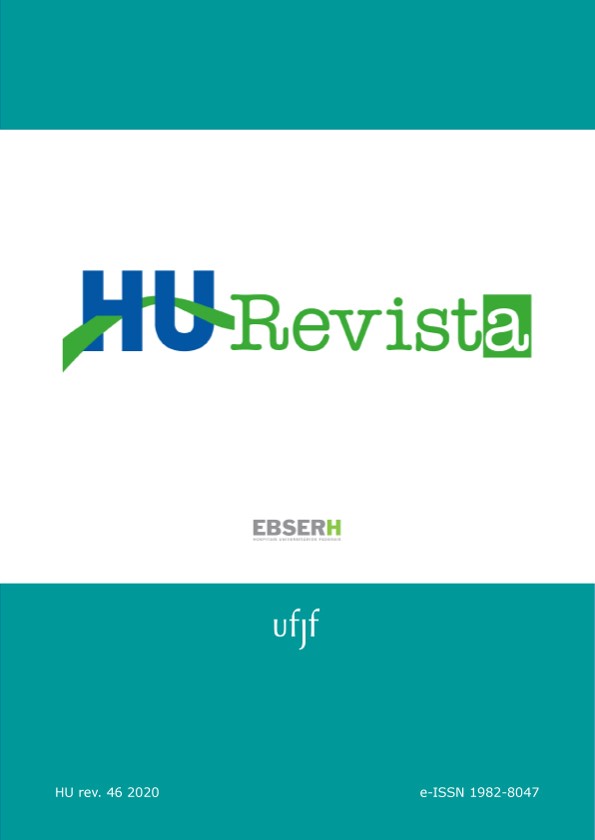Supernumerary tooth fused to a maxillary impacted third molar: case report
DOI:
https://doi.org/10.34019/1982-8047.2020.v46.28918Keywords:
Molar,Third, Tooth,Supernumerary, Surgery,Oral, Cone-Beam Computed TomographyAbstract
Introduction: Supernumerary teeth can foundin all regions of the mandible or maxilla, but there is a predisposition to be located in theanteriorregion of the maxilla. Objective: To relate a case of uncommon location of supernumerary tooth in the posterior region of the maxilla. Case Report: A panoramic radiograph suggested a change in the shape of the upper third molar, but it was not possible to obtain the final diagnosis. Thus, a cone beam computed tomography was used to determine the diagnosis of fusion and also assist in surgical planning. A surgical intervention was carried out with the aim of removing the third molar and the supernumerary. Conclusion: In this case, we observed that a cone beam computed tomography shows details of the occurrence, allowing the diagnosis and the possibility of correct approach to the case, avoiding complications and surgical complications.
Downloads
References
Mallineni SK, Nuvvula S, Cheung A, Kunduru R. A comprehensive review of the literature and data analysis on hypo-hyperdontia. J Oral Sci. 2014; 56(4):295-302.
Kashyap RR, Kashyap RS, Kini R, Naik V. Prevalence of hyperdontia in nonsyndromic South Indian population: an institutional analysis. Indian J Dent.2015; 6(3):135-8. DOI:10.4103/0975-962X.163044.
Dhull KS, Dhull RS, Panda S, Acharya S, Yadav S, Mohanty G. Bilateral mandibular paramolars. Int J ClinPediatr Dent. 2014; 7(1):40-2. DOI: 10.5005/jp-journals-10005-1231.
Ozcan G, Sekerci AE, Soylu E, Nazlim S, Amuk M, AvciF.Role of cone-beam computed tomography in the evaluation of a paradental cyst related to the fusion of a wisdom tooth with a paramolar: a rare case report. Imaging Sci Dent. 2016; 46(1):57-62.DOI: 10.5624/isd.2016.46.1.57.
Kato H, Kamio T. Diagnosis and endodontic management of fused mandibular second molar and paramolar with concrescent supernumerary tooth using cone-beam CT and 3-D printing technology: a case report. Bull TokyoDent Coll. 2015; 56(3):177-84 DOI: 10.2209/tdcpublication.56.177.
Ferreira-Junior O, Avila LD, Sampieri MB, Dias-Ribeiro E, Chen WL, Fan S. Impacted lower third molar fused with a supernumerary tooth-diagnosis and treatment planning using cone-beam computed tomography. Int J Oral Sci. 2009; 1(4):224-8. DOI: 10.4248/IJOS09056.
MaderCL.Fusion of teeth. J Am Dent Assoc. 1979; 98(1):62-4.DOI: http://dx.doi.org/10.14219/jada.archive.1979.0037.
Hupp JM, Ellis IIIE, Tucker, MR. Cirurgia oral e maxilofacial contemporânea. 5. Ed. Elsevier;2009.
Schneider LE, Lima PVP, Grasselli S, Galvagni LE, Quoos A, Hoffmann M et al. Radical cirurgical treatment of fused teeth (third and fourth molars): case report. R Ci Méd Biol. 2006; 5(1):80-4.
Abrams RA, Nelson DL. Fusion ofa third molar to a supernumerary tooth with an associated dentigerous cyst. Aust Dent J. 1979; 24(3):141-2.
Hou GL, Tsai CC. Fusion of maxillary third and supernumerary fourth molars. Case report. Aust Dent J. 1989; 34(3):219-22
Dhindsa A, Garg S, Damle SG, Opal S, Singh T. Fused primary first mandibular macromolar with a unique relation to its permanent successors: a rare tooth anomaly. Eur J Dent.2013; 7(2):239-242. DOI:10.4103/1305-7456.110195.
Gadimli C, Sari Z. Interdisciplinary treatment of a fused lower premolar with supernumerary tooth. Eur J Dent.2011; 5(3):349-53.
VonArx T. Anterior maxillary supernumeraryteeth: a clinical and radiographic study. Aust Dent J.1992; 37(3):189-95.
Mortazavi H, Baharvand M. Jaw lesions associated withimpacted tooth: a radiographic diagnostic guide. Imaging Sci. Dent. 2016;46:147-57.
Alhammadi MS, Asiri HA, Almashraqi AA. Incidence, severity and orthodontic treatment difficulty index of impacted canines in Saudi population. J ClinExp Dent. 2018;10:e327-4.
Bayrak S, Dalci K, Sari S. Case report: evaluation of supernumerary teeth with computerized tomography. Oral Surg Oral Med Oral Pathol Oral Radiol Endod. 2005;100(4):e65-9. DOI: http://dx.doi.org/10.1016/j.tripleo.2005.05.065.
Kim KD, Ruprecht A, Jeon KJ, Park CS. Personal computer-based three-dimensional computed tomographic images ofthe teeth for evaluating supernumerary or ectopically impacted teeth. AngleOrthod.2003; 73(5):614-21. DOI:10.1043/0003-3219(2003)073<0614:PCTCTI>2.0.CO;2.
Ghaeminia H, Meijer GJ, Soehardi A, Borstlap WA, Mulder J, Vlijmen OJ et al. The use of cone beam CT for the removal of wisdom teeth changes the surgical approach compared with panoramic radiography: a pilot study. Int J Oral Maxillofac Surg.2011; 40(8):834-9.DOI:10.1016/j.ijom.2011.02.032.
Sarıca İ, Derindağ G, Kurtuldu E, Naralan ME, Çağlayan F. A retrospective study: do all impacted teeth cause pathology? Niger J Clin Pract. 2019; 22:527-33.
Additional Files
Published
How to Cite
Issue
Section
License
Cessão de Primeira Publicação à HU Revista
Os autores mantém todos os direitos autorais sobre a publicação, sem restrições, e concedem à HU Revista o direito de primeira publicação, com o trabalho licenciado sob a Licença Creative Commons Attribution que permite o compartilhamento irrestrito do trabalho, com reconhecimento da autoria e crédito pela citação de publicação inicial nesta revista, referenciando inclusive seu DOI.









